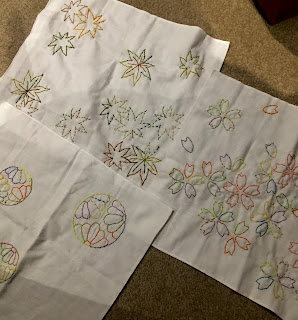
 I got sucked in badly with some Debbie Bliss yarn on special at Loveknitting. I have three drawers of wool and had vowed to buy no more until I am down to one drawer. But I caved and bought enough to knit each of my daughters a jacket from the pattern book conveniently marketed alongside the yarn.
I got sucked in badly with some Debbie Bliss yarn on special at Loveknitting. I have three drawers of wool and had vowed to buy no more until I am down to one drawer. But I caved and bought enough to knit each of my daughters a jacket from the pattern book conveniently marketed alongside the yarn. When it arrived I was determined that this would not end up in the drawers with the rest of my yarn, so set to straight away. So anxious was I to ensure I knitted it that I did not stop to photograph the first (purple) one at all. I thought I had taken photographs as I ironed the pieces, but no evidence exists, so I must have dreamt that. Progress on knitting projects does not, I think, make for much of a narrative, but I regret failing to photograph anything at all of the purple jacket.
When it arrived I was determined that this would not end up in the drawers with the rest of my yarn, so set to straight away. So anxious was I to ensure I knitted it that I did not stop to photograph the first (purple) one at all. I thought I had taken photographs as I ironed the pieces, but no evidence exists, so I must have dreamt that. Progress on knitting projects does not, I think, make for much of a narrative, but I regret failing to photograph anything at all of the purple jacket.
It knitted up beautifully. I usually go for fully natural fibre yarn for knitting, so this is a bit of a deviation for me. It produced a completely smooth fabric. You have to look closely to discern the stitches.
 My only complaint about the pattern is that the instructions for making the buttonholes is added to the end of the instructions for the fronts - well after you have knitted the rows where the holes should go. Fortunately it was not difficult to separate the knitted yarn and buttonhole-stitch in appropriate places.
My only complaint about the pattern is that the instructions for making the buttonholes is added to the end of the instructions for the fronts - well after you have knitted the rows where the holes should go. Fortunately it was not difficult to separate the knitted yarn and buttonhole-stitch in appropriate places.I was pleased to make use of some buttons I had collected - paua shell for the purple one and soap stone ones on the green -both from New Zealand.
 As I had more than a ball of the purple left and two balls of the green, I made cowls, with a simple lace pattern and then fingerless gloves.
As I had more than a ball of the purple left and two balls of the green, I made cowls, with a simple lace pattern and then fingerless gloves. I have enjoyed getting back into knitting I have so much wool in my stash that I could knit for years, but with more embroidery classes giving me ideas there is a bit of competition!
















